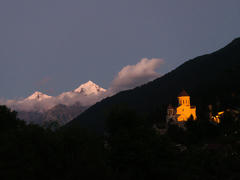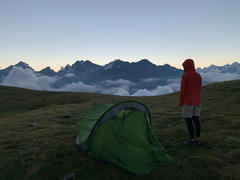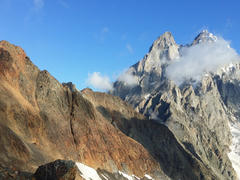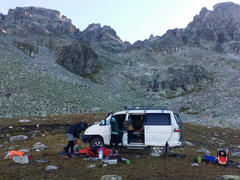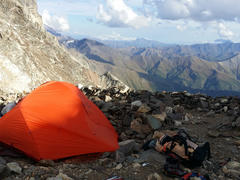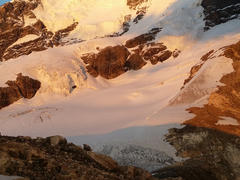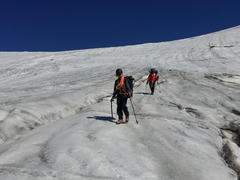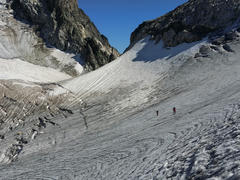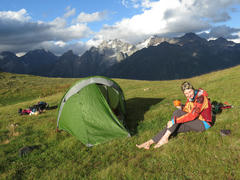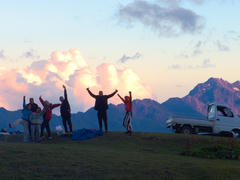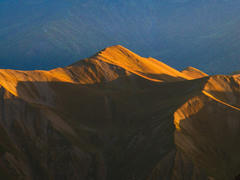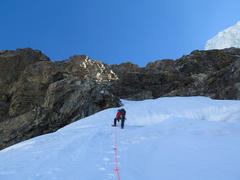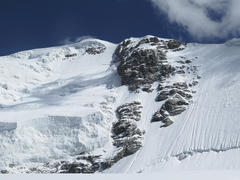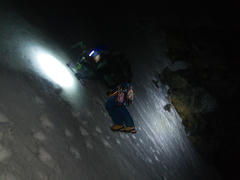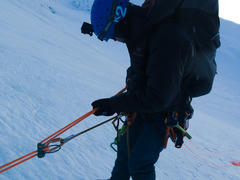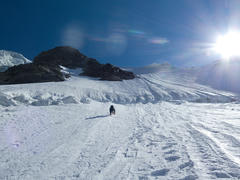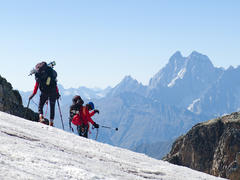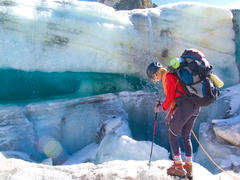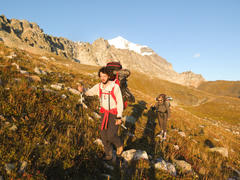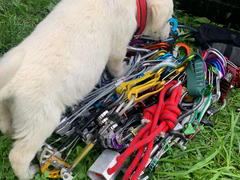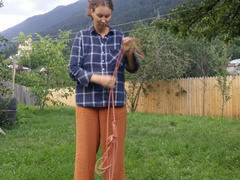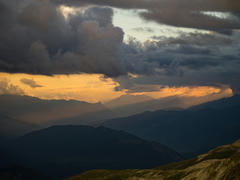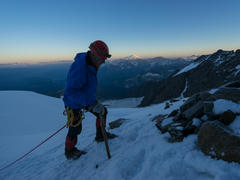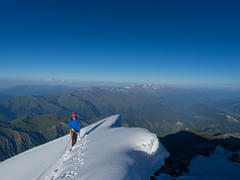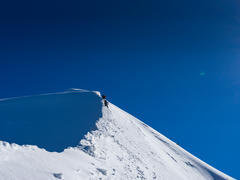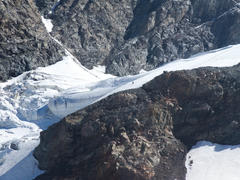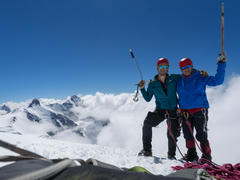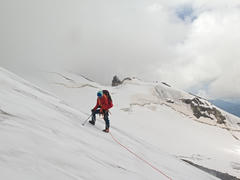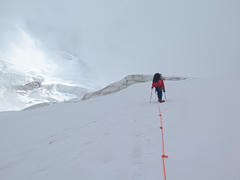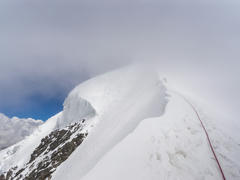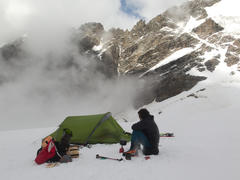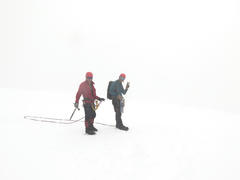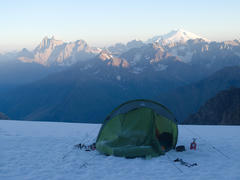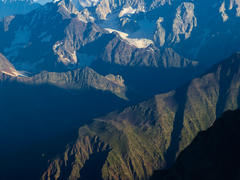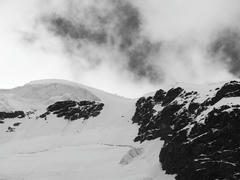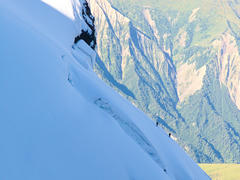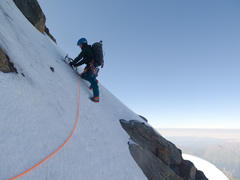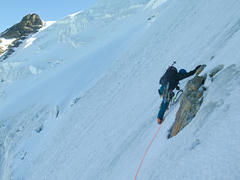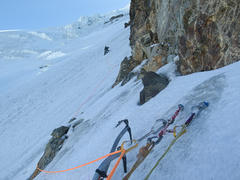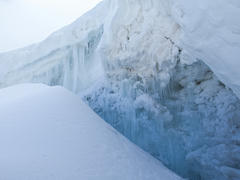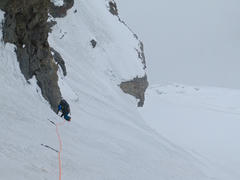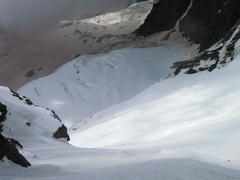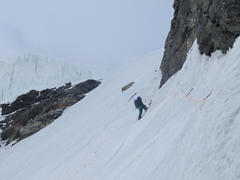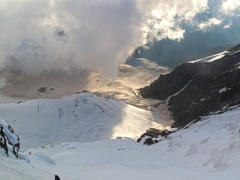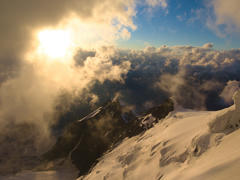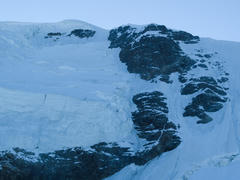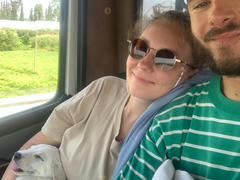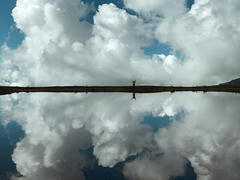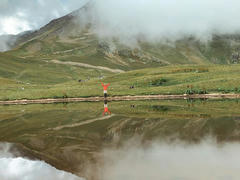Tetnuldi is a striking, snow covered peak in the region of Svaneti, Georgia. Standing within view of the popular township of Mestia, on a clear evening the sun sets last on its face and lights up like beacon above the town. Ryan, is an American who was living in Georgia. Through mutual friendship connections he had lent me a rope for use climbing on Kazbek. I had heard that he was looking for people to climb something technical with, and together over messenger we hashed a plan to climb Tetnuldi in the late Summer of 2020. This was to be Ryan's third time on the mountain, having already climbed the standard route, we had a goal to climb the West Face, about 700m of steep snow and ice via a couloir and alongside a huge serac/hanging glacier.
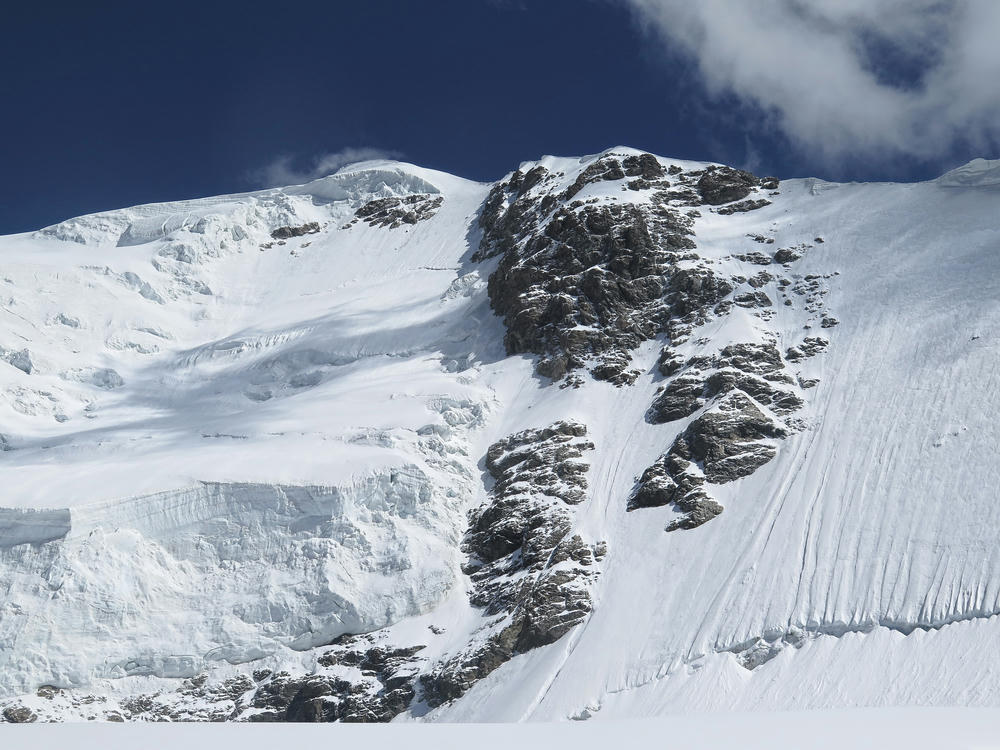
Anya and I arrived in Mestia early, and managed to time our arrival with the strict COVID lockdown for the township, however for some reason our guest house (basically a home stay with a very friendly family) was not subject to the same rules as those staying in the hotels, and we were allowed to roam, making a hiking trip up to the picture perfect Koruldi lakes above the town. As the month rolled by, the climbing trip was delayed until the road was open again and the tourists were set free from their confinement.
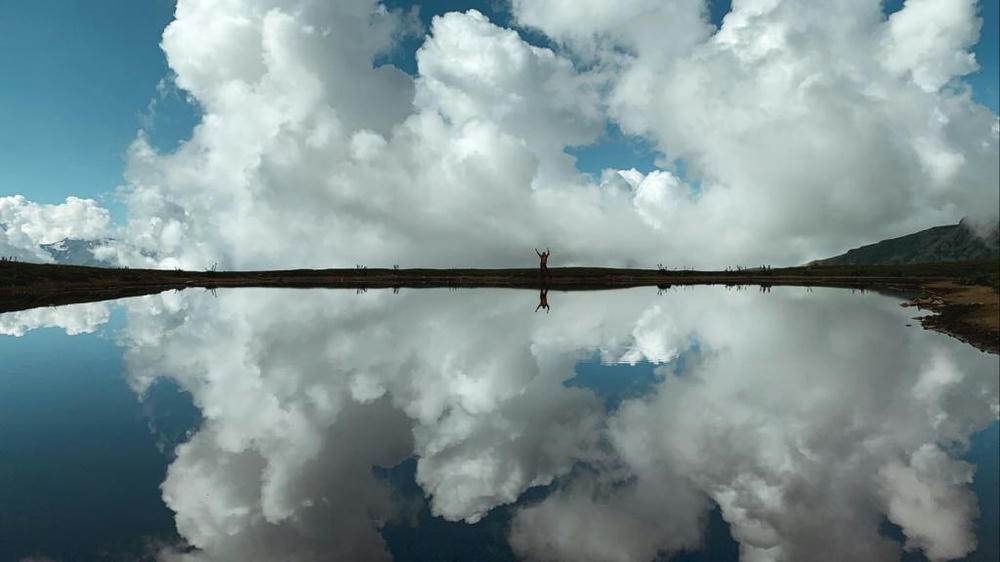
Ryan arrived in his Delica with his partner Lucy who would be joining us for the hiking portion of the trip. We drove up past the Tetnuldi ski resort during the evening and camped next to the trail head. Because the borders were essentially closed due to COVID were were interested as to whether we would encounter any other climbers, tourists, or guides. We started the hike in the morning, casually walking through the fields of flowers and boulders alongside the wall retaining the Nagebi Glacier.
After a couple of kilometers we directed our steps inevitably towards a steep gully filled with loose rocks, which contained a faint line indicating that hiking activity had indeed taken place there. In the end, it was not traumatic, and we reached the Nagebi Glacier at the top fairly easily, donning our crampons. It was Lucy's first time walking on ice, so we had her in the middle of the rope, and conservatively traveled through the steep rolling glacier terrain to reach the base camp.
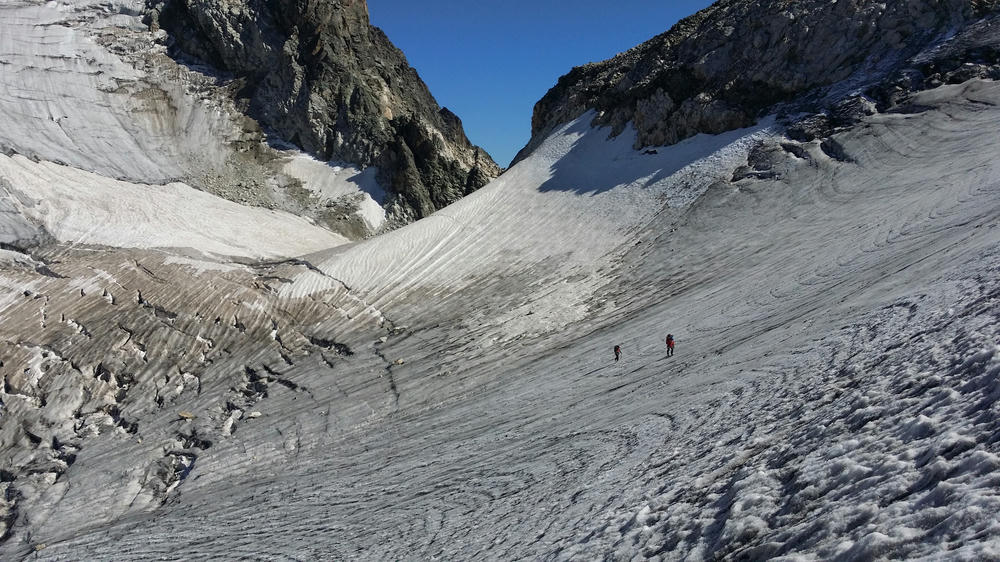
Acclimatization
The campsite was empty, we had the place to ourselves! A storm rolled in and the wind picked up, we hunkered down in the tent, and lightning struck a nearby hilltop, the place felt lonely and wild. The next morning, with a blue sky over our heads, Ryan and I headed out to acclimatize and check the approach to our planned route. There were two obvious options for reaching the upper bench below the face: one was to stay left, and follow the ridge next to the glacier, pretty much the standard route, and the other was to punch up a steep 200m couloir filled with snow straight to the objective. We settled on the latter, as it looked more interesting, and potentially faster.
The purchase was good for our feet, with a thin later of firm snow, and the climbing was fun. We soon gained the upper bench at about 4000m. We sat admiring the route in its full glory, eating lunch in the sunshine. Mission accomplished we returned to camp, descending via the standard route.
During the descent we placed a couple of ice anchor rappels, which happened to be "A threads" (vertical V threads). I had been introduced to using V threads during my climbing education, however I was aware of A threads and some of their benefits, so was totally down to use them when Ryan suggested it. This is an important detail for later. Here is a video explaining A thread from an AMGA/IFMGA guide Steve House. There is a paper "Ice Climbing Anchor Strength: An In-Depth Analysis" by Beverly and Attaway which compares the strengths of the various orientations. TLDR, A threads are easier to clean and are at least as strong, perhaps stronger than the classic horizontal V thread orientation. Some people also recommend them specifically for the situation where one feeds the rope directly through the anchor for the purpose of a rappel without leaving behind cord.
We arrived back just as the afternoon was baking, once again the sunset was spectacular and another evening storm passed us by. I marvelled at the stark transition from ice and rock to the steep green hillsides beyond. Svaneti is truly a magical place.
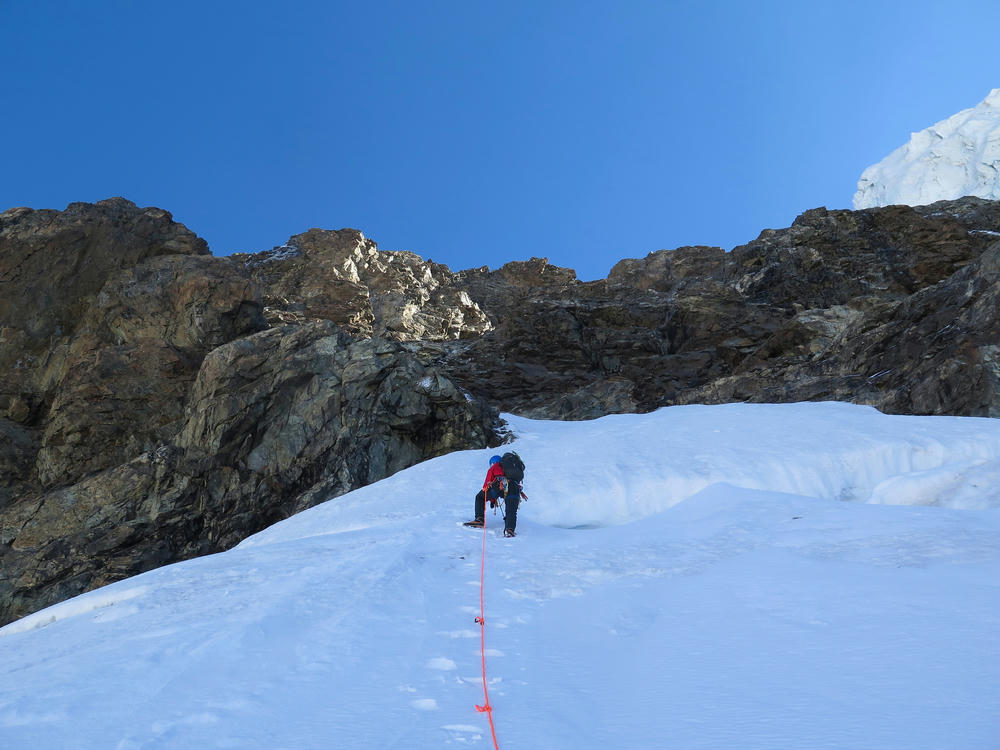
Climbing Day
We awoke the second morning at base camp, somewhere between 2 and 4am. We decided to solo the first couloir and the first few pitches of the face because the footing was good and it would save us a lot of time avoiding rope work. We reached the bench feature and cleared the schrund onto the face proper. It was at this point we began to realise that the face we wanted to climb consisted more of hard, glacial ice than of snow. We chopped a ledge and extracted the rope from a backpack.
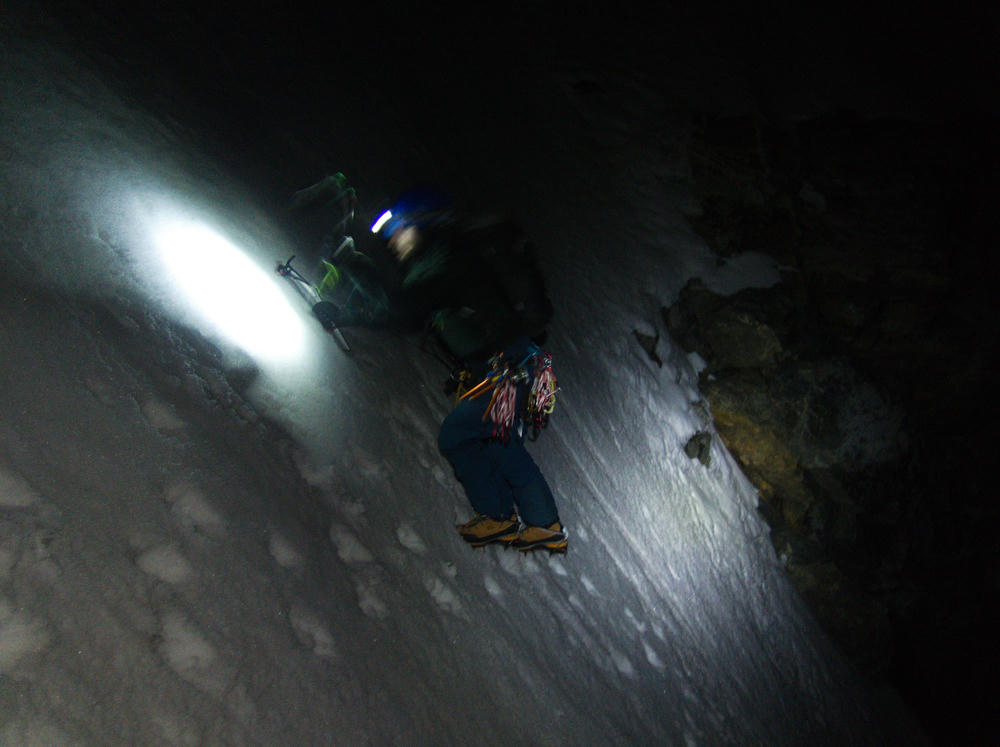
At this point we began pitching up hard and brittle ice. The ice screws felt solid, but my relatively soft boots and horizontal crampon front points were unsuitable for these conditions. After leading the second pitch I was pretty tired by the time I had constructed a belay. When Ryan arrived I had come to the conclusion that we were not going to be able to climb the face, we were of one mind in this regard and the decision to turn around was easy. With only a single rope for descent, the prospect of bailing half way up the face also seemed like a bad idea.
Descending casually via the route from the previous day, we lazily decided to re-use our anchors which did not appear to have melted out too much, and were still frozen fairly solid in the morning.
That afternoon we relaxed at camp, and as the weather began to close in again, we heard a group of climbers approaching from below. Some Georgian guides and their protégés had arrived. I managed to strike up a friendly conversation with Galo, a ski racer on the Georgian national team, who I had previously met on our hike to Koruldi lakes. For him, this was a practice trip with some experienced guides, part of his training to become a mountain guide in Svaneti.
That evening we lent the guide group our spare stove, perhaps one of theirs had broken, I forget, and as we were due to walk out the next morning, we wouldn't need it. We woke up to see their headlights high up on the mountain above. It was a casual and very sunny day, we left camp at about lunch time, ambling our way back down the glacier and couloir. The sun was setting once again as we reached our car. Behind us we could hear singing as the fast group of Georgian guides were quickly overtaking us. Ryan had reached the car first and when I arrived he appeared to be receiving some heated conversation from the lead guides.
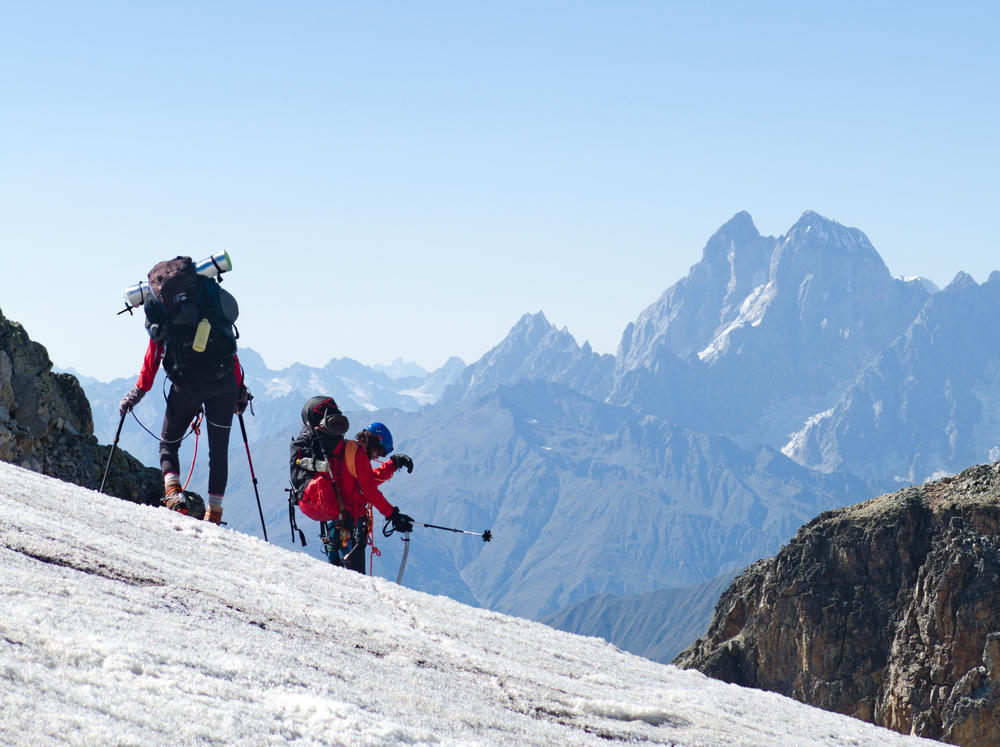
When they departed I asked Ryan what had happened. Apparently, during their descent one of the climbers had decided to use or test one our descent anchors on the lower glacier, and it had failed under load, with no apparent accident occurring. They appeared to be upset that an A thread had been used, taking it as a sign of incompetence, perhaps unaware of the technique. It seemed like Ryan had mostly refrained from arguing being surrounded by a large group who were probably upset, and had taken it in his stride. I couldn't help but notice the irony of complaining about an unfamiliar ice anchor failing during the hottest part of the day, placed 3 sunny days previously However I wasn't party to the conversation, and it was quite a while ago now, so I probably forget some details!
They are good guys, and no doubt our only chance for help if there had been an accident. I can sympathise with the Svan perspective, they have often had to deal with incompetent foreign "guides" leading clients on dangerous climbs. No doubt Ryan's Delica and knowledge of the area had him placed in the suspected guide category. Ryan described to me a situation on a previous trip to Tetnuldi with another friend, where he scarily observed a foreign "guide" who had descended the entire knife edge of Tetnuldi's summit ridge with 60 meters of rope out between him and his client with no protection between them to hold a fall. Because you are mostly on one side of the ridge, due to cornices, it is really not easy to jump onto the opposite side should a fall occur.
In November last year the Georgian Mountain Guides Association (GMGA) was accepted into the International Federation of Mountain Guides (IFMGA), which is exciting news and a big accomplishment. Hopefully there will be more cross-pollination of techniques and ideas for the benefit of everyone climbing in the region.
I think it was in the Winter/Spring of 2020/2021, the route we attempted to climb was skied by a Georgian, a very impressive feat! The steep rock buttress in the middle of the face (a very ambitious route) was solo climbed in 4 hours by a Georgian, Temur Kurdiani in the Autumn of 2020.
I made a short video from the first trip, available on YouTube:
Snowy
Fast forward a year, and in Summer 2021, Ryan and I were ready to give Tetnuldi another crack. This time I had traded my previous mountaineering boots in for a more rigid pair at the second hand equipment store in Tbilisi. Anya and I headed to Mestia early again, I had the idea of doing some paragliding, more on that in a future article. Anyhow, on one of my days out flying Anya had discovered an abandoned puppy sitting next to the road next to our guest house.
We decided to take care of her until we could find her a new home (as bringing her to Australia would be too much of an ordeal on top of our other concerns), she captured our hearts and was dubbed "Snowy". We had her in a cardboard box out in the back yard, however another big summer storm arrived and she began to get wet so we snuck her in the door and had her in the corner of the room.
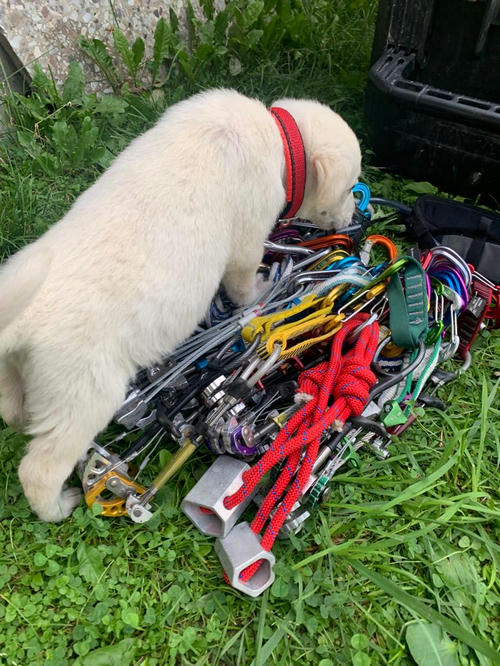
Take Two
Ryan arrived shortly thereafter, bringing with him some worms medication for Snowy. We sorted our gear with an inquisitive puppy climbing all through our ropes, who was feeling much healthier having rid herself of a sizeable quantity of wriggling passengers. The two of us set off once again up the mountain. After one night at base camp we opted to move camp up to the bench feature at about 4000m for a shorter summit day and better acclimatization. It is in some ways eerily close to the bottom of the face and below the serac and summit cornice, however I suppose only a truly massive collapse would have the possibility to reach us several hundred meters away and up a small hill.
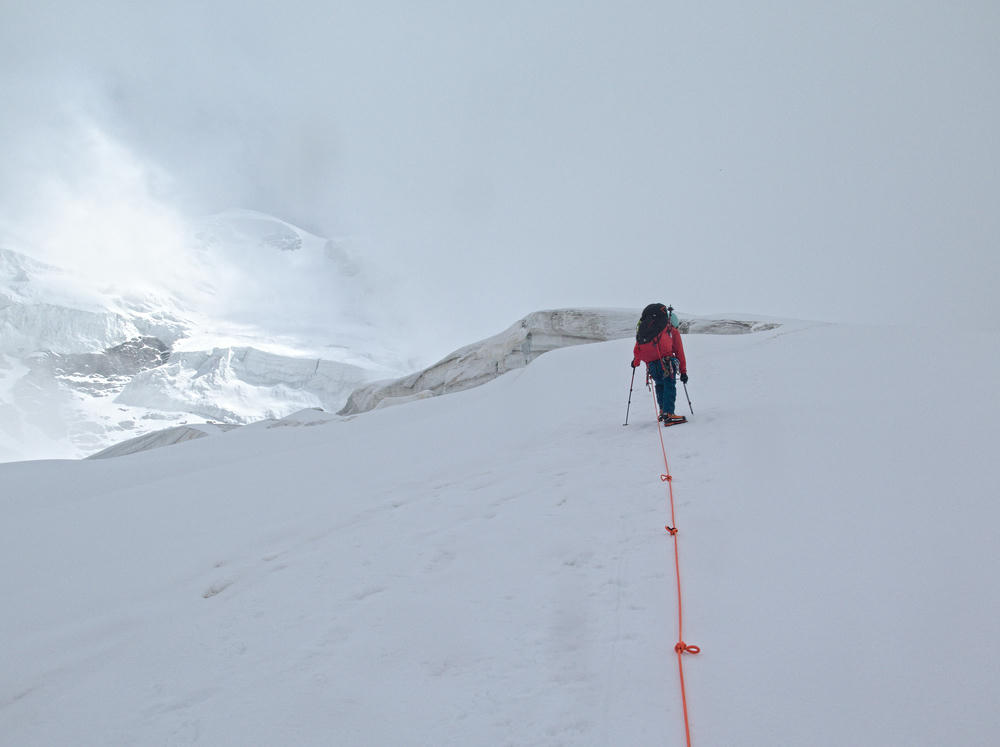
In the afternoon we made friends with some friendly Ukrainian climbers returning from the summit just before the storm arrived, a father Leonid and his son Alexey. I've kept in touch with them since our climb, and Alexey sent me some photos and words to include in the post about their time on Tetnuldi during this trip:
I realized how difficult write about usual things like spending time in the mountains while we have a war. We waited for this trip for a long time. We had too much work and we wanted just to rest in the mountains, Georgia mountains. This trip was not usual we were celebrating father's (Leonid's) 80th (birthday). And we did as usual in the mountains with a cup of Georgian wine. This time we did two ascents on Laila and Tetnuldi and met a lot of nice people. I very much want to visit Georgia again, but we have unfinished things at home, in Ukraine.
I was amazed how well Leonid is climbing for his age, it's incredible. I hope there will be peace again soon!
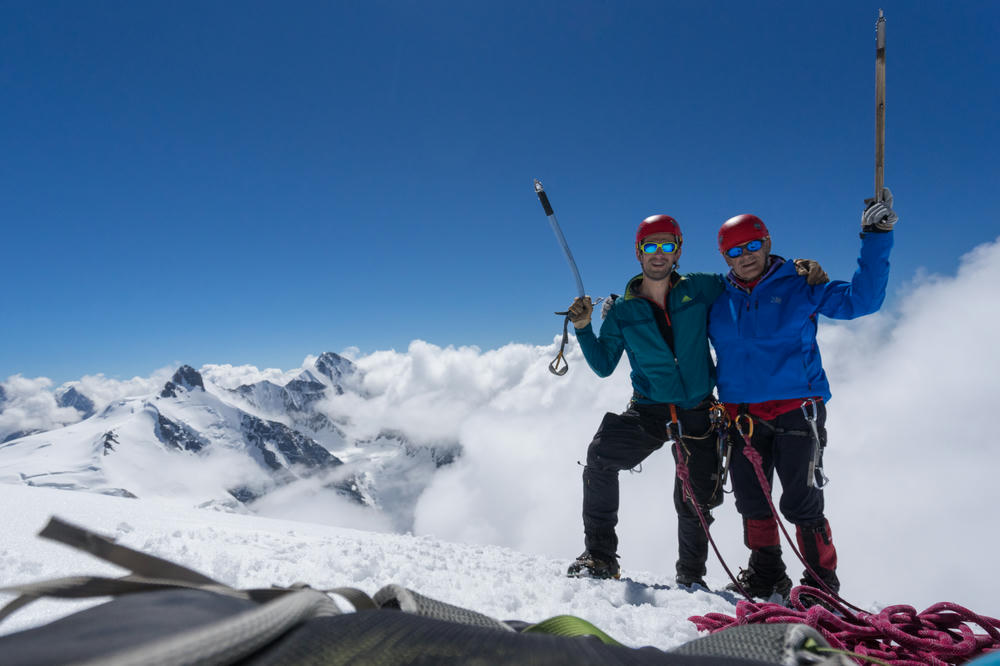
When we arrived there was plenty of snow on the West face and we felt very confident about the climb. We were tent bound for the next day, the weather consisted of a rain and graupel storm that proceeded to strip the entire face of snow back to bare ice and we were left with something that appeared harder than it was during our first attempt!
The following morning we work up very early, the summit push began shortly after midnight. Every pitch was fairly hard ice, so we pitched the entire 700m face, and arrived at the ridge top just on sunset. We were both very tired on the final steep pitch, both secretly hoping the rope lengths would work out that we wouldn't need to lead it! When I poked my head over the other side I saw dark clouds brewing to the East and lightning flickering. Ryan hurried up to join me and we descended in the dark as quickly as we could manage, praying that the storm would pass us by. The top part of the ridge was super icy and required simul-climbing given our tired state. I was a little worried about making a footing mistake in our tired state, but we continued slowly and carefully. We arrived back at the tent almost exactly 24 hours after starting!
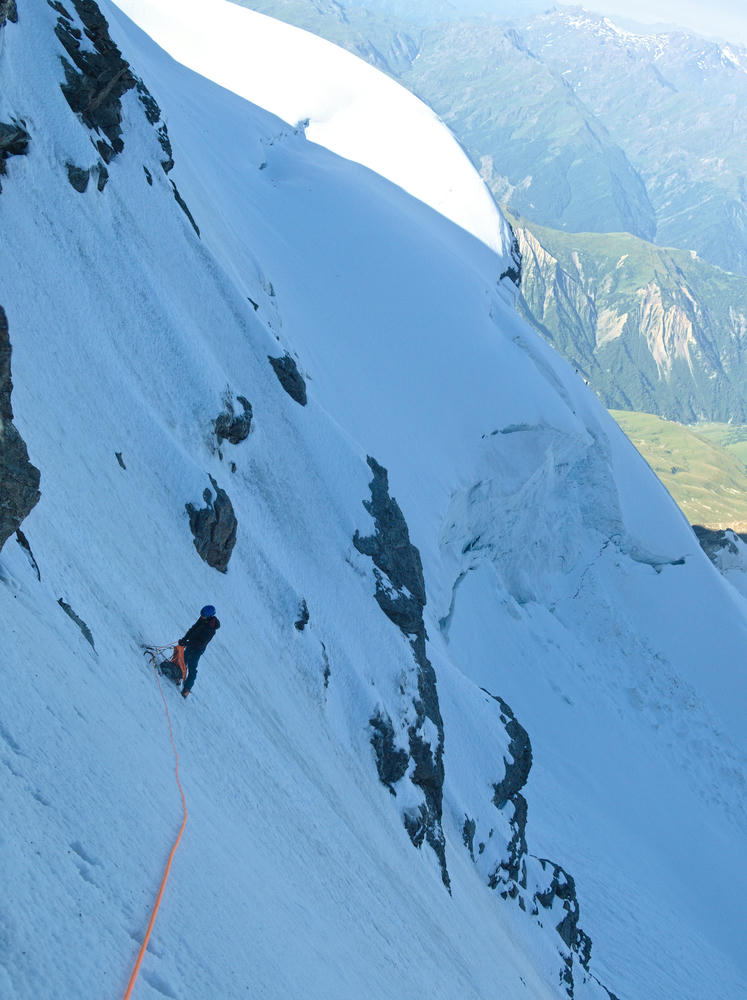
When we arrived back in Mestia we were both completely drained, but very satisfied! I was so happy that we managed a climb which was challenging, exciting, it felt big and we did it in a manner that seemed pretty safe as far as mountaineering exploits go. We a good night sleep and had one morning for resting in Mestia, then in the afternoon we left to begin driving to Tbilisi. It was Anya's birthday and I had something planned to celebrate soon.
While we were driving, both of us were feeling tired, about 40 minutes out of Mestia I took the wheel and several minutes later managed to clip an inside corner while looking down for half a second for something on the console. A momentary lapse in concentration was all it took, residual fatigue is real! It was super lucky that the car didn't roll or go over the side. We hit a rock and were airborne for a short moment, the suspension blew out. Luckily we still had reception and we were just able to call Ryan and organise a tow truck to rescue us, which arrived 4 and half hours later from Zugdidi!
A couple of days later we made it to Batumi to get the car repaired and continue the Summer adventures with Snowy before we found her a wonderful new family in Tbilisi.
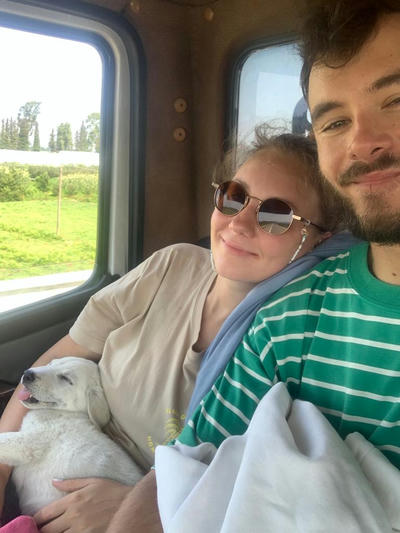
I made a short video from the second trip, available on YouTube:

